7 Conclusion
Activity 17
Perhaps you are asking yourself why there are so many different imaging modalities. Is there not one that will do everything that is required? The answer, at the moment, is ‘No’. With most of the imaging techniques, we considered their advantages and disadvantages. Watch the following video clip, and note down what items the clinician should be considering when deciding which imaging technique to use.
Click to view concluding clip [2 minutes 14 seconds]
Transcript: Conclusion
Answer
Risk
What are the risks associated with the technique?
Are there particular risks for this patient?
Are there risks for the staff?
Do the benefits of a correct diagnosis outweigh the risks?
Speed
Is a fast initial diagnosis important?
Is the procedure very lengthy, and so not suitable for some patients?
Image quality
Will the image show the required information?
What resolution will be achieved and will it be sufficient?
Does the image show function or structure?
Cost
Is the technique too costly to use for a routine preliminary diagnosis?
We hope that you wish to learn more about the science behind these imaging techniques, and others that were not covered here. To do this you will need to enrol on the S809 Imaging in medicine course.
